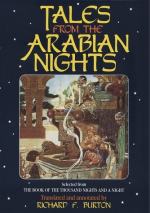1. The Apologue or Beast-fable proper, a theme which may be of any age, as it is found in the hieroglyphs and in the cuneiforms.
2. The Fairy-tale, as for brevity we may term the stories based upon supernatural agency: this was a favourite with olden Persia; and Mohammed, most austere and puritanical of the “Prophets,” strongly objected to it because preferred by the more sensible of his converts to the dry legends of the Talmud and the Koran, quite as fabulous without the halo and glamour of fancy.
3. The Histories and historical anecdotes, analects, and acroamata, in which the names, when not used achronistically by the editor or copier, give unerring data for the earliest date a quo and which, by the mode of treatment, suggest the latest.
Each of these constituents will require further notice when the subject-matter of the book is discussed. The metrical portion of The Nights may also be divided into three categories, viz.:—
1. The oldest and classical poetry of the Arabs, e.g. the various quotations from the “Suspended Poems.”
2. The mediaeval, beginning with the laureates of Al-Rashid’s court, such as Al-Asma’i and Abu Nowas, and ending with Al-Hariri A.H. 446-516 = 1030-1100.
3. The modern quotations and the pieces de circonstance by the editors or copyists of the Compilation.[FN#127]
Upon the metrical portion also further notices must be offered at the end of this Essay.
In considering the uncle derivatur of The Nights we must carefully separate subject-matter from language-manner. The neglect of such essential difference has caused the remark, “It is not a little curious that the origin of a work which has been known to Europe and has been studied by many during nearly two centuries, should still be so mysterious, and that students have failed in all attempts to detect the secret.” Hence also the chief authorities at once branched off into two directions. One held the work to be practically Persian: the other as persistently declared it to be purely Arab.
Professor Galland, in his Epistle Dedicatory to the Marquise d’O, daughter of his patron M. de Guillerague, showed his literary acumen and unfailing sagacity by deriving The Nights from India via Persia; and held that they had been reduced to their present shape by an Auteur Arabe inconnu. This reference to India, also learnedly advocated by M. Langles, was inevitable in those days: it had not then been proved that India owed all her literature to far older civilisations and even that her alphabet the Nagari, erroneously called Devanagari, was derived through Phoenicia and Himyar-land from Ancient Egypt. So Europe was contented to compare The Nights with the Fables of Pilpay for upwards of a century. At last the Pehlevi or old Iranian origin of the work found an able and strenuous advocate in Baron von Hammer-Purgstall [FN#128] who worthily continued what Galland had begun: although a most inexact writer, he was extensively read in Oriental history and poetry. His contention was that the book is an Arabisation of the Persian Hazar Afsanah or Thousand Tales and he proved his point.




